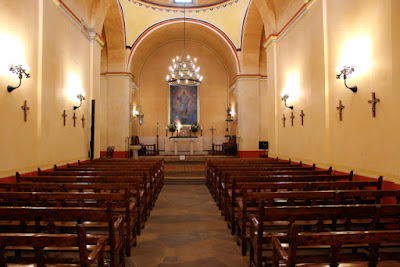San Antonio (Texas) has the largest collection of Spanish colonial missions in the United States and five of the missions have recently been designated as a UNESCO World Heritage Site. The five missions are San Antonio de Valero, Concepcion, San Jose, San Juan, and Espada.
Of the five missions, San Antonio de Valero (founded in 1718 and also known as "The Alamo") is the most famous because it was the site of the 1836 Battle of the Alamo.
In January of 1836 the Texans had insufficient men to protect the Mission, so Sam Houston sent Jim Bowie and 30 men to evacuate the people, remove the artillery, and destroy the complex, so that it would not fall into the hands of Santa Anna and the Mexican Army. However, once at the Mission, Bowie decided that he would rather die than surrender the mission to the Mexicans, so he decided to disobey orders and stay at the Alamo.
Over the next few days William Travis arrived with a few men and then Davy Crockett and other volunteers arrived to help defend the complex. By late February all of the settlers in the area gathered at the Alamo with their food and supplies, waiting for a battle with the Mexican army.
When Santa Anna arrived with a much larger army than anticipated, he raised a blood-red flag that signified "no quarter" (surrender or they would take no prisoners). The red flag was ignored; so on March 6 the Mexican army attacked the Alamo and killed all of the men, leaving the women and children alive to tell the story of what had happened.
This infuriated the Americans and soon the cry "Remember the Alamo" spread throughout the United States and within a few weeks Sam Houston recruited enough troops to defeat Santa Anna at the Battle of San Jacinto. The San Jacinto battle is often called the most one-sided victory in history because 650 Mexican soldiers were killed and another 300 were captured, while only 11 Texans died and 30 were wounded. Santa Anna was captured and released, then he went on to have a very interesting future.
Throughout history, there have been six different flags that have flown over the Alamo. One flag from each nation is on display in the courtyard. To add a little extra excitement, they recently discovered that one of the cannons on display had not been fired during the battle and it was still loaded!
Following Mission Trail south along the San Antonio River, Mission Nuestra Senora de la Purisima Concepcion is the next mission complex. Although the grounds and out-buildings have changed, the National Park Service states that the church looks exactly like it did in the mid-1700s. Some of the original paints still exist on the ceilings and walls.
In 1720 Fray Antonio Margil de Jesus founded Mission San Jose y San Miguel de Aguayo, which was one of the best know of the Texas Missions and is still one of the favorite missions to visit.
Mission San Jose was known for its unique architecture and was considered to be the model mission organization. Because of the mission's size, it became known as the "Queen of the Missions." The main building contains the legendary Rose Window.
The courtyard is still intact and surrounded by housing units that make up the courtyard walls.
Mission San Juan Capistrano was originally called Mission San Jose de los Nazonis and was known for its fertile farmland and pastures. The orchards and gardens produced peaches, melons, pumpkins, grapes and peppers and the irrigated fields produced corn, beans, sweet potatoes, squash, and sugar cane in such abundance that they supplied food for the other missions. The pastures contained grazing for about 3,500 sheep and the same number of cattle.
Mission San Francisco de los Tejas was founded in 1690 and renamed Mission San Francisco de la Espada in 1731. It was Spanish policy that missionary life be similar to Spanish villages' life, so the missionaries taught Indians vocations to become blacksmiths, carpenters, stone masons, and construction workers. This mission is the only complex in the area to be constructed from bricks that were made at the site.

































No comments:
Post a Comment